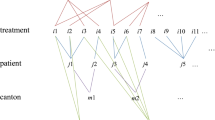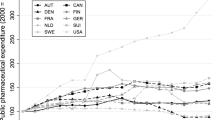Summary
This article measures the impact of the switch to new and more expensive drugs on the aggregate drug expenditure (both prescription and nonprescription) in Sweden during the period 1974 to 1991, and also on the disaggregated expenditure for 3 medical areas: asthma, hypertension and peptic ulcer disease. During the period studied, nominal drug expenditure increased 6-fold. The retail price index of drugs and the number of prescribed drugs accounted for 51.6 and 5.8% of this increase, respectively. The remaining residual amount accounted for 42.6%. Since the price index of drugs increased more slowly than the overall net price index of goods and services, the relative price of drugs decreased dramatically by about 30%. This means that increases in prices of drugs cannot explain the increase in real inflation-adjusted drug expenditure. We also show that the residual increase can be partly explained by the introduction of new and more expensive drugs. It is therefore argued that economic evaluations which compare the extra costs induced by new drugs with the extra benefits should be undertaken to guide decisions about the prescription of new and more expensive drugs.
Similar content being viewed by others
References
Ädelroth E, Thompson S. Advantages of high-dose inhaled budesonide. Lancet 2: 476, 1988
Ädelroth E, Thompson S. Högdosinhalationssteroider vid astma: analys av kostnader och vårdutnyttjande. Läkartidningen 81: 4285–4288, 1984
Drummond MF, Stoddart GL, Torrance GW. Methods for the economic evaluation of health care programmes, Oxford Medical Publications, Oxford, 1987
EFPIA in figures: The Pharmaceutical Industry in Europe 1989–1990, European Federation of Pharmaceutical industries’ Associations, 1991
EFPIA in figures: The Pharmaceutical Industry in Europe 1990–1991, EFPIA, 1992
Freund DA, Dittus RS. Principles of pharmacoeconomic analysis of drug therapy. PharmacoEconomics 1: 20–31, 1992
Geweke J, Weisbrod BA. Expenditure effects of technological change: the case of a new drug. Evaluation Review 8: 74–92, 1984
Johannesson M, Borgquist L, Jönsson B. The costs of treating hypertension: an empirical investigation in primary health care. Scandinavian Journal or Primary Health Care 9: 155–160, 1991
Johannesson M, Jönsson B. Economic evaluation in health care: is there a role for cost-benefit analysis? Health Policy 17: 1–23, 1991
Johannesson M, Johansson P-O, Jönsson S. Economic evaluation of drug therapy; a review of the contingent valuation method. PharmacoEconomics 1: 325–337, 1992
Johannesson M, Wikstrand J, Jönsson B, Berglund G, Tuomilehto J. Cost-effectiveness of antihypertensive treatment: metoprolol versus thiazide diuretics. PharmacoEconomics 3: 36–44, 1993
Johansson P-O. An introduction to modern welfare economics, Cambridge University Press, Cambridge, 1991
Jönsson, B. Cost benefit analysis in public health and medical care. Liber, Lund, 1976
Jönsson B, The pharmaceutical market. In Bourdet (Ed.) Internationalization, market power and consumer welfare, Routledge, London, 1992
Jönsson B, Carlsson P. The effects of cimetidine on the cost of ulcer disease in Sweden. Social Science and Medicine 33: 275–282, 1991
National Corporation of Swedish Pharmacies (NCSP), Svensk Läkemedelsstatistik, Stockholm, 1989
National Corporation of Swedish Pharmacies (NCSP), Svensk Läkemedelsstatistik, Stockholm. 1992
Ståhl I, Can health care costs be controlled? A study in production and development in health care, Dialogos, Lund, 1986
Weisbrod BA. A guide to benefit-cost analysis, as seen through a controlled experiment in treating the mentally ill. Journal of Health Politics, Policy and Law 7: 805–845, 1983
Wikstrand J, Warnold I, Tuomilehto J, Olsson G, Elmfeldt D, et al. Metoprolol versus thiazide diuretics in hypertension: morbidity results from the MAPHY study. Hypertension 17: 579–588, 1991
Zöllner, H. Measures to control the costs of pharmaceutical prescriptions in Europe, WHO/EURO internal draft document. 1984
Author information
Authors and Affiliations
Rights and permissions
About this article
Cite this article
Gerdtham, UG., Johannesson, M. & Jönsson, B. Drug Expenditure and New Drug Introductions. Pharmacoeconomics 4, 215–225 (1993). https://doi.org/10.2165/00019053-199304030-00006
Published:
Issue Date:
DOI: https://doi.org/10.2165/00019053-199304030-00006




